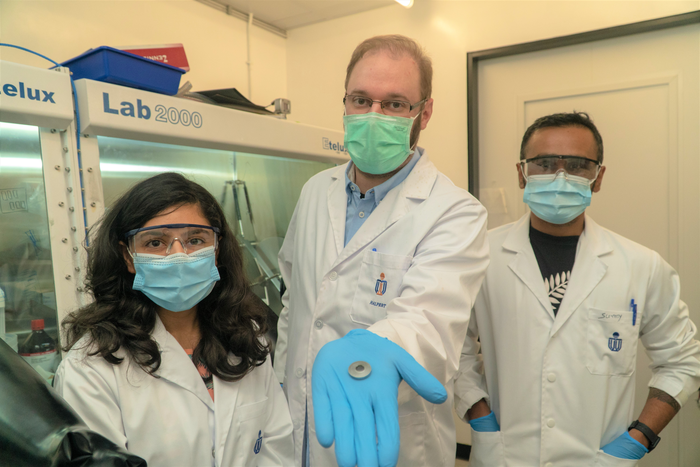A group of scientists from The Hong Kong University of Science and Technology (HKUST) created a lightweight, low-cost, and non-toxic (lead-free) photo-battery that features dual functions.

A research team led by Professor Jonathan Eugene Halpert (middle), Assistant Professor from the Department of Chemistry at HKUST, develops an inexpensive, lightweight, and lead-free photo-battery that has dual functions in harvesting solar energy and storing energy on a single device. Image Credit: The Hong Kong University of Science and Technology.
The battery developed can harvest solar energy and store it on a single device, enabling charging under the sun rather than plugging the device into the wall.
The ever-rising need for sustainable energy sources has created a surge of interest in solar energy and creating storage devices for it. One such device, the photo-battery, can generate and store energy in single device architecture.
Theoretically, this design should enhance energy storage efficiency and density while lessening ohmic losses, relaxing packaging requirements, and decreasing the system's weight, expense, and bulk.
However, in reality, the poor interface between materials tends to generate problems with charge transport. This highly decreases the efficiency compared to a simple solar cell system wired to an external battery.
Researchers headed by Professor Jonathan Eugene Halpert, Assistant Professor from the Department of Chemistry at HKUST, have made developments toward creating more effective photo-batteries by broadening the utility of a class of materials named perovskites, which are used in solar cells and more recently in batteries.
The perovskite halide created by the team acts as a photoelectrode that can harvest energy under illumination without the support of an external load in a lithium-ion battery.
It contrasts with its prevailing counterpart as it does not possess lead and therefore has greater stability in the air and is free of lead poisoning. Researchers replaced lead with bismuth (Bi), a non-toxic element, forming a strongly light-absorbing crystalline material in the current research.
The lithium-ion battery operates by permitting electrons to move from a high energy state to a lower one while working in an external circuit. The mechanism of a photo-battery is similar to an ordinary battery except that it is not necessary to supply current or plug into the wall to be charged electrically, but can be charged photoelectrically under the sun.
The active material in this novel battery is the lead-free perovskite which, when kept below the light, absorbs a photon and generates a pair of charges, termed an electron and a hole.
The researchers carried out chrono-amperometry experiments under light and in the dark to examine the increase in charging current generated by the light, registering a photo-conversion efficiency rate of 0.428% on photo-charging the battery after the first discharge. The researchers eventually tested with various materials for enhanced performance and efficiency, facilitating the commercialization of photo-battery in the market.
At present, we plug all our appliances into the wall to charge them. With further development in this field of photobatteries, we might not have to plug them in at all in the future. We might be able to harvest solar energy and use it to fulfill the power requirements of any devices with modest power needs.
Jonathan Eugene Halpert, Assistant Professor, Department of Chemistry, Hong Kong University of Science and Technology
“Our work is one of the initial steps taken in this field, and, of course, a lot of improvements will be needed to achieve better performance, but we are confident that we can improve its stability and average efficiency with further refinement,” added professor Halpert.
The photo-battery developed can serve as the built-in battery for devices like tablets or smartphones, and even remote energy storage applications, which can be easily made with these photo-batteries as they are portable and lightweight. It is also anticipated to help reduce production costs when compared to a system containing a solar cell plus an external battery as only the battery part is required.
Journal Reference:
Tewari, N., et al. (2021) Photorechargeable Lead-Free Perovskite Lithium-Ion Batteries Using Hexagonal Cs3Bi2I9 Nanosheets. Nano Letters. doi.org/10.1021/acs.nanolett.1c01000.